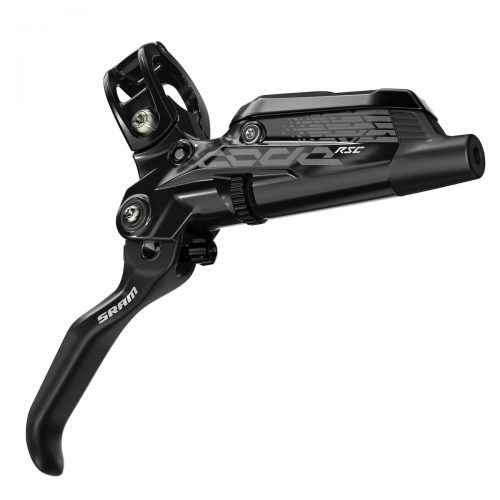The ultimate in stopping power.
The Avid Code disc brake is dead. Long live the SRAM Code brake! New brand name for a heavily overhauled brake system.
Need to know
- Powerful four-piston alloy calliper with 15 and 16mm diameter phenolic plastic pistons
- Forged alloy master cylinder and lever blade
- Larger fluid volume for consistency
- Full featured: SwingLink, Contact Point Adjust, Lever Pivot Bearing
- Bleeding Edge bleed process
- Claimed weight: 433 grams (160mm rotor)
- SRP: £229 (per end w/o rotor)

The previous Code brake design has been around for a good number of years so a redesign comes as no surprise. The Code brake is still a four piston calliper brakes designed for Downhill and gravity riders but its new design is significantly different and genuinely new.
In some ways the new SRAM Code brakes feels like it’s been inspired by the fairly common ‘hack’ of running Code callipers but pairing them with Guide brake levers. Maximum power but with more feel and modulation than a full-on Code setup.

SRAM Code first ride impressions
We spent a couple of days at the beginning of April in the Forest of Dean testing the new Code RSC brake and the first thing we noticed was the redesigned reach adjustment made setting the lever for different hand sizes way quicker than the old brake. The adjuster is also now on the outside of the lever, so is easier to get to, and it’s also easier to turn – the detents don’t seem to get snagged up anymore.
With the increased pad spacing we didn’t experience any rotor rubbing, something that’s pretty common when the brake is new, but the new Swing Link means the pistons travel quicker, so the brake still feels positive.
SRAM claims the Code RSC is around 9% heavier than the equivalent Guide brake but it has managed to increase power by 15%. The thing is the power is so well modulated than the Code never felt grabby, in fact it felt really controllable but with plenty in reserve for hard stops on steep descents, even one-finger braking.
We can’t comment on the durability at this stage but the thing we noticed about the new Code RSC was it had none of the ‘new brake’ squeal. There’s always noise when the pads are still green and haven’t scrubbed in but the Code RSC was reassuringly hushed. Throughout the two days testing the lever feel was also totally consistent, and even yanking really hard it never felt awkward or uncomfortable – like most of its brakes, SRAM has really nailed the shape and overall ergonomics.
Code was originally targeted at the downhill market but we reckon the new model would make a great brake for trail and enduro use. Whether the Code RSC is quite as good as the e-bike specific Guide RE we’ve just tested remains to be seen but that brake is half the price, although the cheaper Code R looks like the one to go for if you’re on a budget.
For some riders the Code may still be a little weighty but if you want the ultimate in stopping power, excellent modulation, smoother engagement and one of the best lever shapes around, it should definitely be on your hit list.



